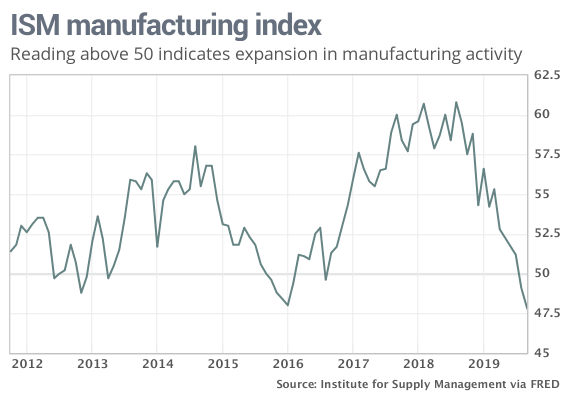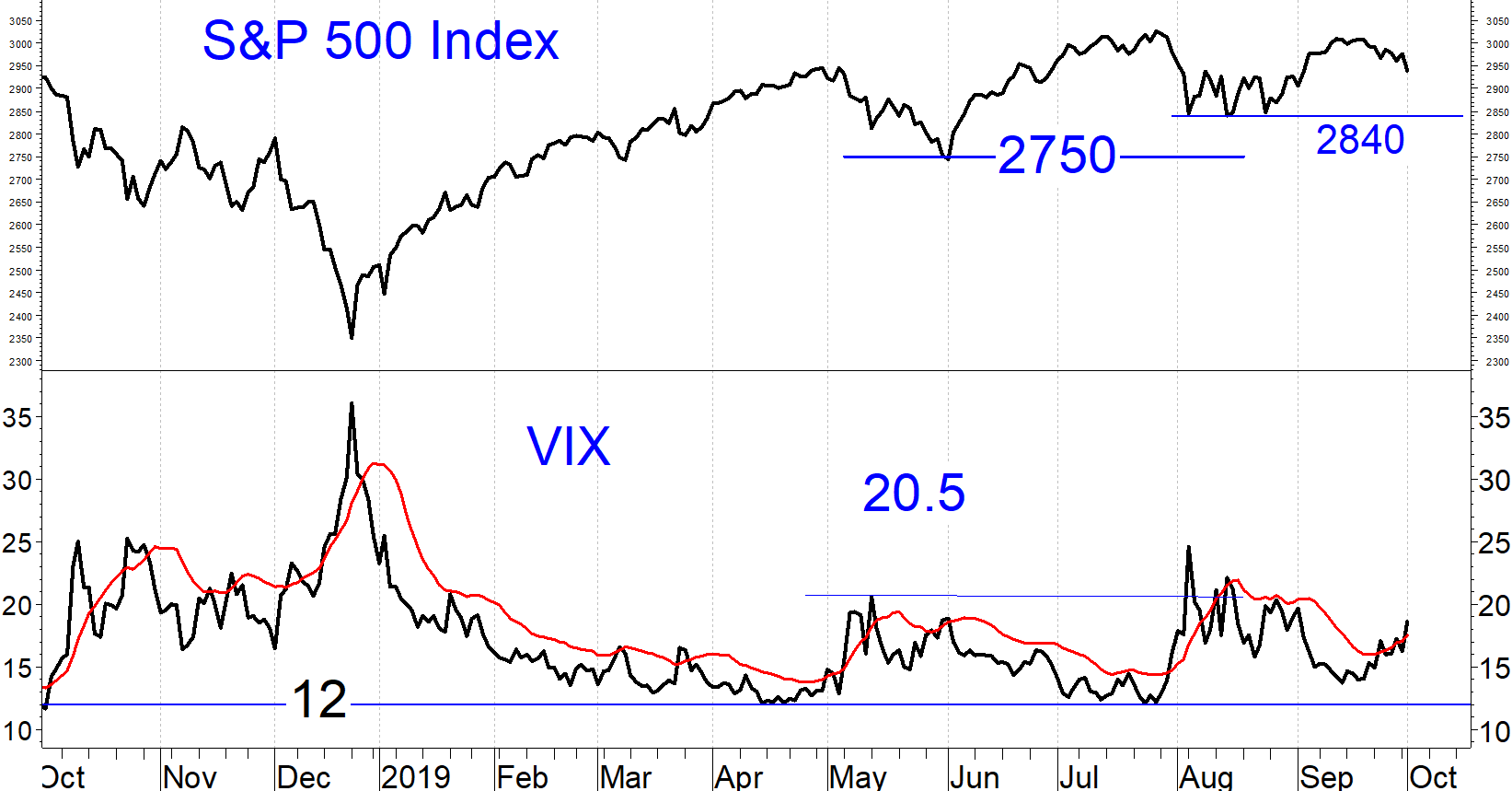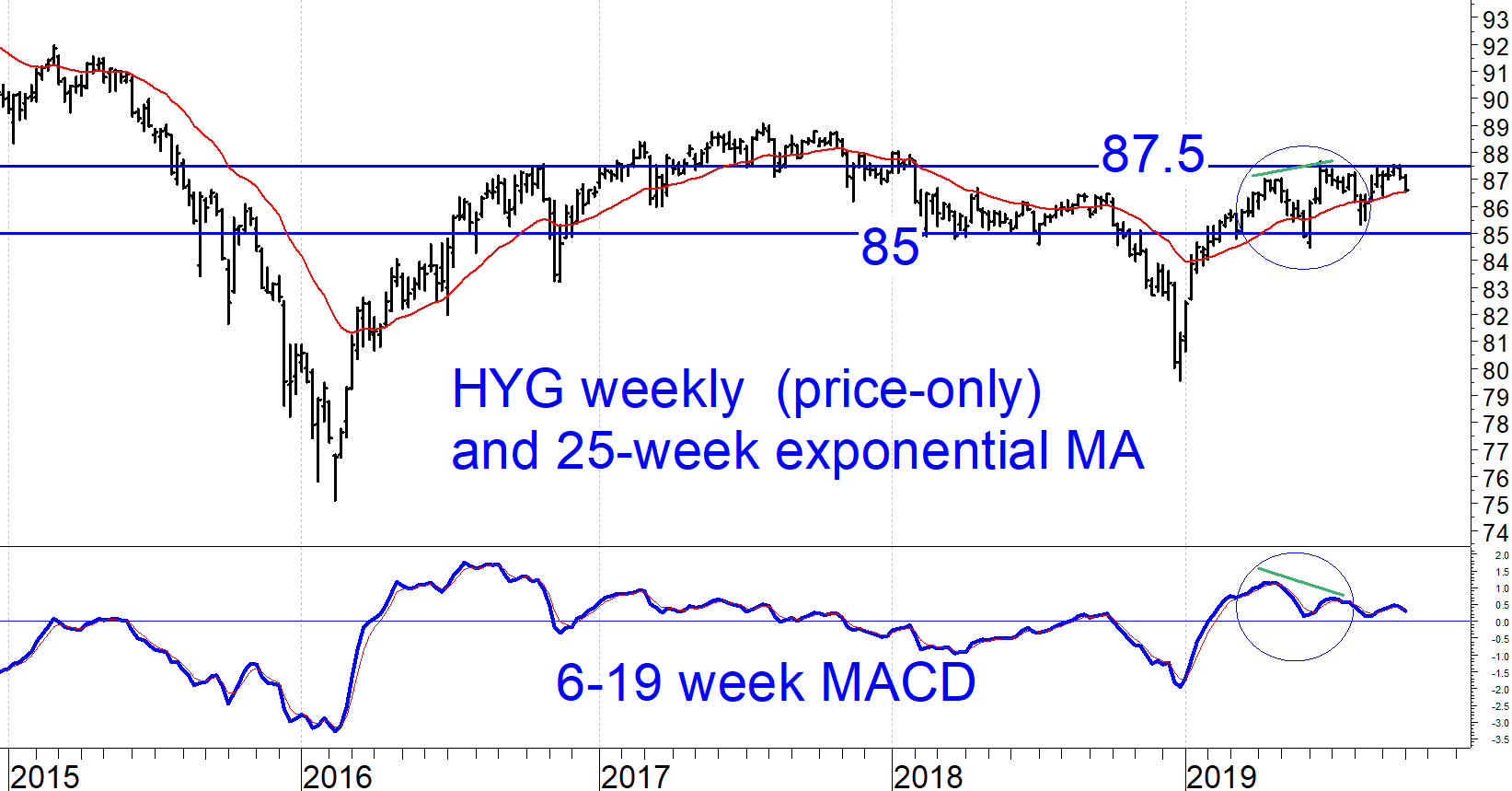Recession fears resurface after yesterday’s drop in the ISM Manufacturing Index, but high yield bonds are not confirming, notes Marvin Appel.
The Institute for Supply Management reported on Oct. 1 that its manufacturing index dropped to 47.8%, its lowest level since June 2009. (See chart below.) This news caused a 1.23% drop in the S&P 500. Any reading below 50% indicates contraction in manufacturing activity in the United States. Note that we saw manufacturing contraction in 2015-2016 that did not lead to an economy-wide recession.

Wednesday, stocks took an even bigger hit (SPY down 1.8%) as ADP reported slower private sector payrolls rose by 135,000 in September, which is actually a sufficient pace to keep up with the growth in the labor force but less than the rate of job creation we saw in 2018 (214,000 per month) or year-to-date (145,000 per month).
How much further will this sell-off go? In terms of the S&P 500, 2840 was a strong support level in August and is therefore a logical downside objective this month. That is roughly 1.5% below where we are today.
Another source of near-term support is the pop in option implied volatility as measured by the Cboe Volatility Index (VIX), which exceeded 20% intra-day on Oct. 2. This spike in VIX represents a near-term oversold market condition that historically, has been a good bottom-fishing area for a one-week trade (see chart).

Figure: S&P 500 Index and the VIX; 2840 is the nearest support level and is likely to be retested in October. VIX tends to move in the opposite direction as the market on a day-to-day basis, so extreme peaks in VIX usually coincide with intermediate-term market bottoms.
Bottom-fishing trade
The 2840 support level and the jump in the VIX suggests covered call writing as a good risk-adjusted way to bottom-fish. Intra-day on Oct. 2, at-the-money SPY calls expiring on Nov. 15, 2019 are offering more than 2.5% while Dec. 20, 2019 calls are offering more than 3.3% in time value (SPY shareholders will also receive the Dec. 20, 2019 dividend of approximately 0.5% if their shares are not called).
The trade I recommend is to buy SPY at 284 and write 284-strike calls that expire on Dec. 20. You should be able to open this position at a net debit of 273 (paying 284 for the shares of SPY but offsetting that cost by 11 for writing the option), although the cost may vary depending on VIX when/if SPY falls to 284.
Hold the position until expiration or until (if) the sell signal reverses. If you want to have a sell stop, keep in mind that 274 was the area of the May and June closing low for SPY, so a close 2% below that level—268—could be a sell stop.
Longer term outlook
A developing recession would be very bad for stocks. On the other hand, recessions that have not materialized caused shorter-lived market corrections as in 2015-2016 and 2018. Unfortunately, stock market sentiment is very unstable. Two weeks ago, the Industrial Sector SPDR (XLI) made a new high, but this week pessimism is in the air; industrials have slipped further than the S&P 500, the defensive consumer staples sector has outperformed the S&P 500, Treasury note yields have fallen. It is easy to identify developments to describe today’s sentiment but hard to find indicators with prognostic value.
I continue to believe that the high yield bond market will serve as the canary in the coal mine. The chart below shows that the iShares Corporate High Yield Bond ETF (HYG) remains in its uptrend from the start of the year, and near the top of its two-year trading range. Moreover, the six/19-week MACD remains above zero which, in my experience, is a bullish bond market indicator.

The implication is that even if the economy is due to slow down, the high yield bond market is still acting in a manner that is providing no recession warning. Our course of action for client accounts is to maintain portfolios of below-maximum volatility, including a cash position to deploy when our main U.S. equity timing model goes back on a buy and the use of balanced mutual funds. With a portfolio quiet enough to meet your safety requirements, you can ride out the current volatility.
Sign up here for a free three-month subscription to Dr. Marvin Appel’s Systems and Forecasts newsletter, published every other week with hotline access to the most current commentary. No further obligation.





















